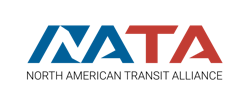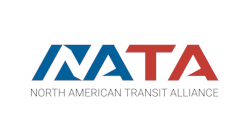Q&A with the executive team at the North American Transit Alliance
The North American Transit Alliance (NATA) formed in 2020 during the COVID-19 pandemic. NATA’s member companies, which include First Transit, Keolis, MV Transportation, National Express, RATP Dev USA and Transdev, are working to promote innovative transportation solutions that ensure transit is safe, clean and prepared for the challenges that lie ahead.
How did the idea of the North American Transit Alliance come about? And why is now the right time to form this alliance?
Amid the COVID-19 crisis, it has become increasingly evident that public transit needs the ability to quickly adapt to unexpected challenges. The North American Transit Alliance was founded by six of the largest private contractors to advocate for innovation in public transportation and for its workforce, who serve and transport some of our most vulnerable citizens, including seniors and paratransit-eligible riders. NATA was created during the COVID-19 pandemic at a time when countries, their economies and public health were put under tremendous strain and faced unprecedented challenges. This crisis has highlighted the importance of public transportation across North America and the need for public transit authorities, private operators and lawmakers to work together to ensure that all people, regardless of location or socioeconomic status, can safely travel within communities.
Aside from the global pandemic, public transit faces the same challenges that every industry must address – equity, climate change, accessibility and efficient service are just a few of the difficulties that require innovative solutions to ensure that the future of transit is personal, equitable and sustainable. As the six largest public transit operators in North America, we felt a sense of duty to the communities we serve to create an organization that advocates for effective public transportation systems, plays a leading role in setting cities and communities across North America up for a brighter future and restores confidence in public transportation.
Can you expand on what a “personal, equitable and sustainable” future may look like and how the industry can reach it?
Equity, personalization and sustainability are three of the most important guiding factors for the future of public transportation. NATA believes that all transit systems should be:
- Equitable - Public transportation systems should serve all citizens equally, regardless of their location or socioeconomic status. Historically, regions can experience “transit deserts,” which represent underserved regions and populations. Oftentimes, those who live in these transit deserts are public transportation dependent as they may not be able to afford a personal vehicle. Transportation providers and PTAs must be more mindful to ensure that all areas that they serve are given equal access to modes of public transportation. This may mean auditing current systems; adding additional bus lines, rail lines or microtransit services; and/or working with local governments to install bike or scooter racks to help people move more easily. It comes down to understanding demand and bringing innovations to our existing systems to provide better mobility.
- Personal - Personalized service is vital to the continued success of public transportation. In the age of ride-hailing services, riders have never had more information, control or options. Shifts toward Mobility-as-a-Service (MaaS) allows passengers to have a more personalized experience on public transportation, including apps that allow passengers to pay for tickets/fare, track vehicles or predict the most efficient routes for any given passenger.
- Sustainable - As vehicles, specifically single-occupancy vehicles, are a major contributor to climate change, ensuring that transportation systems are using the most sustainable methods possible is a vital next step for the transportation industry. According to the Federal Transit Administration, transportation accounts for 29 percent of greenhouse gas emissions in the United States. By moving more people with fewer vehicles, public transportation can reduce greenhouse gas emissions. National averages demonstrate that public transportation produces significantly lower greenhouse gas emissions per passenger mile than private vehicles. By reducing congestion, transit also reduces emissions from cars stuck in traffic. Finally, transit can minimize its own greenhouse gas emissions by using efficient vehicles, alternative fuels and decreasing the impact of project construction and service operations.
- How we can reach it as an industry? NATA was created because we believe that private transportation operators bring a unique value proposition and can bring ideas to the table that will help pave the way for tomorrow’s mobility. This group brings together the experience and knowledge of six companies that make up 35 percent of the U.S. public transportation workforce, represent more than 154,000 total employees, operate in 46 states and 2,111 cities and represented 19 percent of total U.S. passenger trips. We are all working with transit systems that have their own set of challenges and that vary in shape and size. We are well-positioned to tackle the biggest challenges ahead by sharing resources and knowledge while working closely with riders and non-riders; communities; public officials; start-ups and all other stakeholders involved in the transportation ecosystem.
Technology and its ability to sway post-COVID-19 transit recovery was mentioned by NATA members interviewed for Mass Transit’s June cover story “Mobility Redefined” and technology was also referenced in the NATA announcement regarding the establishment of the alliance. The term “technology” is broad; but are there areas specific ways or areas where NATA and its members can help propel the transit industry forward through technology?
Advancements have been made in customer experience and service, employee training and modes of transportation:
- Customer Experience and Service – In the past 20 years, technology has rapidly changed our habits, as well as consumer expectations across all industries. Transit is no exception. As an example, future passengers will expect to be able to plan a trip from point A to point B from one platform, even if that requires using multiple modes of transportation to reach their destination. Additionally, at a growing rate, contactless payment and ticketing solutions will be expected. Transit will need to continue to keep the pace with technology to meet passenger needs and expectations, while also serving existing passengers who are less willing to adopt new technology.
- Employee Training – As with all professions, experience and improved training correlates with fewer mistakes. Today and going forward, technology serves as an aid for training professional vehicle operators and creating safer roads. This creates opportunities for safe and efficient employee training.
- Modes of Transportation - Advancements in autonomous vehicles, microtransit and sustainable vehicles are on the forefront of technological innovations in the transportation space. Transit needs to strike a delicate balance of embracing these new modes of transportation without over-investing in technology that is going to be obsolete in a short period of time. NATA will help guide the industry in this space.
- Most recently, sanitization – During the COVID-19 pandemic, transit has continued to maintain service while also integrating additional cleaning procedures. This often required modifications to many vehicle operation schedules. In some cases, this means using new cleaning technology. All sanitation methods need to be cost-effective, safe and efficient to ensure that vehicles are fully disinfected. NATA members will continue to help find solutions to ensure transit is safe.
What do NATA members see as short-term and long-term challenges for transit?
Short-term challenges for transit include:
- COVID-19 Recovery: As an essential service, transit has had to quickly adapt to ensure the safety of passengers and operators. Though we continue to address the repercussions of COVID-19 in the short term, we expect that many of these changes will be more permanent or require future adjustments to the transit industry as a whole, including social distancing measures and enhanced cleaning procedures. Additionally, even as reopening takes place, public transportation will likely face the continued challenge of changing ridership trends. To counteract this issue, transit operators will need to implement new, more personalized and accessible transit services, such as microtransit routes.
Long-term challenges for transit include:
- Climate Change: Climate change is one of the most prominent challenges that transit can address. We already know that public transit contributes fewer emissions than personal vehicle usage. Our industry needs to continue to provide solutions to climate change by reducing transit’s own emissions while still adapting to changing consumer behavior.
- Access: As mentioned above, equitability and accessibility to public transit for all populations is an ongoing challenge. Moving forward, we must audit current and plan future transportation systems to ensure that all community members receive equal access to transportation services.
- Ride Sharing: TNCs have caused a shift in transportation usage by the general public. Transit should embrace this shift by participating in MaaS solutions. This will allow public transportation systems to provide customer centric and viable addition to ridesharing services.
Switching gears to advocacy, it is both an opportune time with surface transportation reauthorization efforts underway and a challenging time with COVID-19 precautions still in place for a new advocacy voice to be heard. Has NATA developed an agenda for these efforts, and can you share the highlights?
You are correct; this is a critical time to advocate for transit funding and supportive policies, and NATA plans to lend our voice to efforts to secure maximum funding and flexibility for public transit systems. NATA has developed an agenda to advocate for public transit and its workforce across North America. NATA will work with lawmakers to ensure that both public transit authorities and private operators receive federal benefits that will empower them to continue serving communities safely, equitably and efficiently.
Our members are innovators – focused on how to deliver public transportation that is most responsive to the needs of the public – using new technologies that benefit transit riders. Our offerings are designed to increase ridership and be cost-effective. We look forward to communicating the important role of the private sector in delivering public transportation and in training our workforce to adapt to new technology and changes in the way people travel.
As new legislation is being developed, NATA will want to ensure that private transit operators receive the consideration that is reflective of their role in public transit. By working together, private transit operators will have one voice to ensure that they and their teams can continue to be on the front lines to support our nation’s recovery.

Mischa Wanek-Libman | Group Editorial Director
Mischa Wanek-Libman is director of communications with Transdev North America. She has more than 20 years of experience working in the transportation industry covering construction projects, engineering challenges, transit and rail operations and best practices.
Wanek-Libman has held top editorial positions at freight rail and public transportation business-to-business publications including as editor-in-chief and editorial director of Mass Transit from 2018-2024. She has been recognized for editorial excellence through her individual work, as well as for collaborative content.
She is an active member of the American Public Transportation Association's Marketing and Communications Committee and served 14 years as a Board Observer on the National Railroad Construction and Maintenance Association (NRC) Board of Directors.
She is a graduate of Drake University in Des Moines, Iowa, where she earned a Bachelor of Arts degree in Journalism and Mass Communication.





